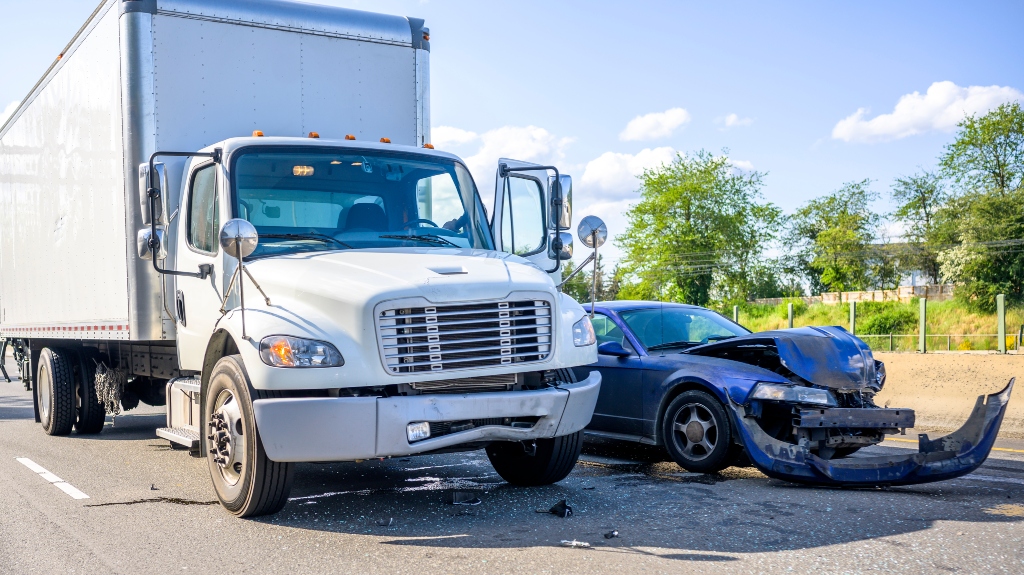Commercial Trucking and Semi-Truck Accidents Attorney in Bozeman, Montana
Contact us if you or someone you care about was hurt or killed by another’s negligence in a semi-truck or commercial motor vehicle crash. Semi-truck and commercial trucking accidents are some of the most devastating crashes that occur in the United States. Each year, innocent people are hurt or killed by careless, negligent, and malicious commercial motor vehicle drivers and those who put them behind the wheel. The Federal Motor Carrier Safety Administration (FMCSA) tracks collisions involving commercial motor vehicles in the United States. In 2021, Montana had the fourth-highest fatality rate in the United States for large truck and bus-involved collisions (per miles driven). This rate was nearly double the national average.
That same year, there were 5,904 police-reported fatal large truck and bus crashes in the United States, according to the FMCSA. These collisions resulted in at least 5,991 deaths. And the number of fatal crashes involving large trucks is increasing. The FMCSA reports a 52 percent increase in fatal crashes involving large trucks or buses from 2010 to 2021. Semi-trucks and commercial motor vehicles often weigh up to 80,000 pounds. Those who drive cars, trucks, motorcycles, and SUVs and are hit by semi-trucks and other commercial motor vehicles are often killed or severely injured by the excessive impact of a commercial truck or semi-truck crash. Even when death and severe injury are avoided, these accidents can cause extensive property damage.
If you were injured by a negligent commercial motor vehicle driver, you will need to determine which parties could be liable for your injuries. This is often far more complex than it may seem on the surface. Speaking with a Montana personal injury attorney will help you determine who may be liable for your injuries. This may require investigating half a dozen or more commercial trucking entities that are related to the semi-truck, its trailer, and its shipment.

What is a Commercial Motor Vehicle?
Commercial motor vehicles are commonly known by several names, including semi-trucks, semi-trailers, tractor-trailers, straight trucks, 18-wheelers, and big rigs, among others. Some of these vehicles are defined differently under the FMCSRs.
A vehicle that has a gross vehicle rating or gross combination weight rating, or gross vehicle weight or gross combination weight, of 4,536 kg (10,001 pounds) or more, whichever is greater, may be a commercial motor vehicle in certain circumstances. Most often, commercial motor vehicle drivers of semi-trucks and similar vehicles are driving vehicles weighing up to 80,000 pounds.
A commercial trucking accident may involve a commercial truck or a private vehicle. The majority of commercial automobiles are heavy, large, and dangerous. Sometimes, commercial trucks transport flammable chemicals that can cause explosions and other hazardous conditions. Even if a commercial truck is traveling at a low rate of speed, it is possible for other drivers and passengers to suffer serious bodily injuries during an accident. Some of the most common types of commercial automobiles include the following:
- Semi-trucks, tractor-trailers, and 18-wheelers
- School buses, city buses, and private buses
- Garbage trucks and refuse trucks
- Dump trucks and construction equipment
- Tow trucks and car haulers
- Delivery vans
- Construction trucks towing trailers and construction equipment
Common Causes of Commercial Vehicle Accidents
Drivers of commercial vehicles must drive with caution. If a driver of a commercial vehicle engages in negligent conduct, then it can have a serious effect on many other drivers and passengers. The following behaviors often cause commercial vehicle accidents:
- Not following the Federal Motor Carrier Safety Regulations and other applicable laws aimed at keeping everyone safe
- Driving in hazardous conditions and weather
- Distracted driving
- Driving while intoxicated
- Fatigued driving
- Improperly loaded cargo
- Not following traffic signals
- Driving at an excessive rate of speed
- Improperly loaded cargo
Semi-truck drivers failing to adjust and account for dangerous road conditions, obstructed roadways, and poor weather conditions lead to most commercial trucking accidents. According to the Federal Motor Carrier Safety Aminstration, about 38% of semi-truck and commercial motor vehicle crashes happen because bad decision making by the driver where the “Driver drove too fast for conditions, misjudged the speed of other vehicles, followed other vehicles too closely, or made false assumptions about other driver’s actions.” Every driver should follow traffic laws and operate their automobiles in a reasonable manner to prevent accidents.
Commercial Trucking Accidents Are Different from Other Accidents
There are numerous differences between semi-truck crashes and crashes involving only cars or other non-commercial vehicles. Commercial trucking accidents often involve employees who work for a corporation or a limited liability company. Liability can be contested in commercial trucking accidents. It can be challenging to prove which party is responsible for the accident. Additionally, both employers and employees may be partly liable for contributing to the commercial trucking accident. If you were injured during a commercial trucking accident, then you may be able to seek financial compensation from the driver’s employer.
Some parties may challenge whether the employee was working at the time the commercial trucking accident occurred. Oftentimes, these types of questions are resolved during trials. Some large companies may not want to negotiate regarding possible settlement offers. Speaking with a personal injury attorney can help you determine which case strategies will benefit you and your family members.
Those who drive commercial trucks are required to hold a commercial driver’s license. Many federal regulations also limit the conditions under which commercial truck drivers are allowed to work. It is not permissible for commercial truckers to drive as much or as often as they choose. Specific limits are placed on the amount of time commercial truckers can drive on the open road.

